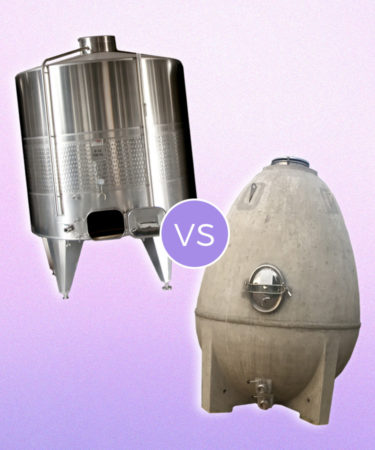For years, oak was the stamp of quality winemaking. Oaked reds were more likely to get top scores by wine critics in the 1980s; and by the 1990s, winemakers sought out ways to impart oak flavors using oak chips and shavings.
But over the past decade, taste trends have shifted. That’s not to say that oak has disappeared in the cellar, but more consumers now seek wines without oak. Winemakers are thus cutting back on new oak usage, and some brands release bottles labeled “unoaked” or “lightly oaked.”
Stainless steel vessels are the most popular options for unoaked wines, but recently winemakers have varied their preferences in the cellar. Over the past decade, more winemakers have started using concrete tanks, a fermentation and aging alternative that offers the best of both steel and oak.
Though any winery visitor is familiar with the looming steel tanks now popular for both red and white wine fermentation, this technology only emerged in the 1950s and 1960s. Prior to this, oak barrels were almost exclusively used to create, store, and even ship wine. But oak vessels had their downfalls. While watertight, oak barrels are not airtight, allowing oxygen to come into contact with wine. They easily house bacteria if not cleaned properly.
Stainless steel tanks, on the other hand, offered a cleaner, more controlled way of fermenting and storing wine, allowing winemakers to make a fresher style with more fruit and acidity rather than texture and oaky or oxidative flavor.
Over time, some winemakers felt stainless steel tanks were too sterile, sometimes producing sharp, linear wines that couldn’t breathe. Enter the concrete tank, a heavy, thick-walled vessel that comes in many shapes and sizes, from standard ovals to squares, pyramids, and even eggs. Unlike stainless steel, the inner walls of concrete tanks aren’t uniform. They are porous, with thousands of tiny pockets that trap air and allow the wine limited contact with oxygen. Concrete tanks don’t impart any additional flavor, either, making them ideal for winemakers who want to maintain freshness and purity of a grape’s character. Thus, wines created in concrete tanks tend to be bright and fruit-forward, with excellent texture and minerality.
The trend has taken hold in both the Old and New Worlds, where many winemakers feel that concrete’s sturdiness and quality of wine produced outweighs the upfront cost and bulk of the tanks. Historic Bordeaux producer Domaine de Chevalier installed 10 large concrete tanks in 2014, and Argentinian winery El Enemigo exclusively uses concrete eggs for fermentation. And in case it seems like concrete tanks may just be a fashion, know that the trend dates all the way back to the ceramic amphorae of ancient Greek and Roman times.
Looking for a wine with depth and richness that stays away from the obvious flavors of new oak? Seek out wines aged in concrete tanks and discover winemaking’s happy medium.
